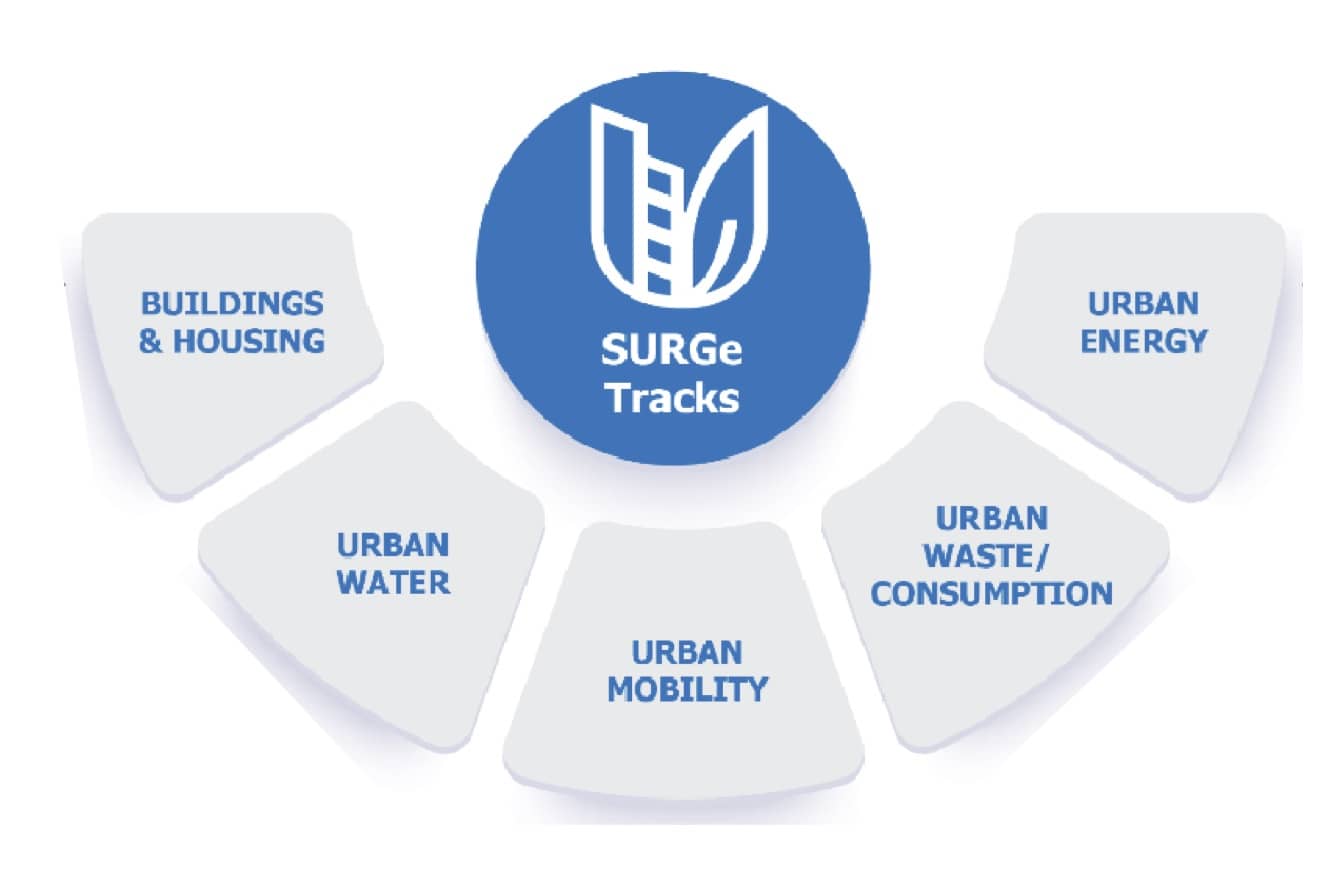
www.buildingsandcities.org/insights/commentaries/launch-surge-cop27.html
The Launch of SURGe at COP27: Breakthrough or Déjà Vu?

By Jeroen van der Heijden (Victoria University of Wellington)
The overall outcomes of COP27 (held in Sharm El-Sheikh, Egypt) have been reported by some as disappointing. However, leading city networks such as C40 and ICLEI claim that subnational governments and cities have made a significant breakthrough with the launch of the Sustainable Urban Resilience for the Next Generation initiative (SURGe). This commentary explores how much of a breakthrough this really is.
What is SURGe?
SURGe is an initiative of the COP27 Presidency in collaboration with UN-Habitat and facilitation of ICLEI. It was launched at the first-ever COP Ministerial for Urbanization and Climate Change. SURGe aims to accelerate local and urban climate action. It seeks to contribute to achieving the Paris Climate Goals and Sustainable Development Goals (SDGs) through multilevel governance, engagement, and delivery through five integrated tracks: building and housing, urban energy, urban waste and consumption, urban mobility, and urban water.
SURGe points out that several vital barriers exist in limiting urban emission reductions, building urban system resilience, and adapting urban systems to climate change. These include a lack of multilevel and cooperative action, a lack of climate finance for cities, and a lack of capacity in cities for developing and planning climate actions. SURGe also points out that feasible measures are available to reduce greenhouse gas (GHG) emissions in cities by 90% by 2050 but that technological and process innovations do not reach all cities because of significant research and action gaps.
SURGe expresses a vision for 2030: "Effective multilevel governance to transform cities to be healthy, sustainable, just, inclusive, low-emission and resilient urban systems for a better urban future for all." It seeks to achieve this vision by strengthening the implementation of the climate agenda in and with cities; unlocking urban climate finance; building capacity in cities; and accelerating technology and innovation in cities. In doing so, SURGe aims to ensure equity, acknowledging that vulnerable groups and communities in cities are often disproportionately and adversely affected by climate change.
What will SURGe do?
To achieve these aims, the Global SURGe Alliance was launched. The Alliance provides an advisory function and will present annual progress at future COPs. This Alliance has already been endorsed by over 120 organizations, including national governments, UN organizations, civil society, academia, the private sector and NGOs, and is open for participation by interested stakeholders.
The day-to-day operation of the initiative will be overseen by a Global Secretariat, co-hosted by UN-Habitat and ICLEI. Together with a steering committee and working groups, it will develop a roadmap and vital success criteria for the initiative. In addition, the Secretariat will seek close collaboration with existing programs, partnerships, initiatives, and campaigns.
Five Working Groups will be launched to develop and disseminate knowledge on the five integrated tracks and to advance and accelerate urban climate actions in energy efficiency, urban water use, and circular (urban) economies.
Breakthrough or déjà vu?
The available SURGe documentation uses all the language we have gotten used to since the launch of Local Agenda 21 in 1992. Cities are portrayed as contributors but mainly as victims of climate change. They are depicted as acting where nation-states have failed. Because a substantial number of cities are committing to climate action and reducing GHG emissions, cities are portrayed as potential saviours of the planet. Whilst this language has great normative appeal, it does not fully reflect reality. Yes, some cities have made significant progress in reducing GHG emissions by taking climate actions. Still, the reality is that many cities around the globe are not on track to reach the goals of the Paris Agreement or different goals set by individual cities for themselves, let alone to reach net-zero emissions by 2050 or sooner.
From the available material, it does not become clear directly whether and how SURGe will deliver on its promise. It is hopeful that SURGe presents a holistic view of the various aspects required to achieve the required urban transition(s) to tackle the climate crisis, including buildings, water, waste, energy, and mobility. This may help overcome the siloed nature of urban climate governance and action that cities often face in daily practice. It is also hopeful to see that SURGe already has the buy-in from national, local and regional governments, urban networks, INGOs (international non-governmental organisations) and NGOs (non-governmental organisations), academia, the private sector and utility companies, and a financial institution. This opens a natural road to multilevel and multi-actor governance. But if SURGe is going to be a breakthrough of COP27, then it needs to move quickly and boldly. So far, it remains a founding document with all the current buzzwords (i.e., 'nature-positive' cities, 'circular' cities, 'health-promoting' cities) and a simple website.
Quick wins could come from changing the habit of undertaking ever more urban climate experiments and pilot projects. Instead, SURGe could promote and help city governments implement existing practices that have a proven track record elsewhere. Quick wins could also come from changing the mindset that 'laggard' cities, citizens, and collectives will voluntarily follow 'climate leaders' and rather acknowledge that many will not make a move unless mandated by law and regulations. Bold actions could include expecting binding commitments from participating cities and other stakeholders and holding those who do not stick to their commitments publicly accountable. Bold actions could also include a shift away from presenting cities as "engines of climate action and [being] at the forefront of delivering solutions" to being open and honest about how few cities actually take meaningful climate action, and how little has been achieved, relatively speaking, since the launch of Agenda 21 in 1992.
Only 7 years until 2030
Over the last three decades, we have witnessed a mushrooming of initiatives, platforms, and networks that aim to accelerate urban climate action. Yet, despite their surge, cities are still not en masse transforming to being healthy, sustainable, just, inclusive, low-emission, and resilient. We do not need another 'feel good' initiative that results in much talk but little action. That would be déjà vu all over again.
It is promising that SURGe had a voice at COP27 and will hopefully have a voice at future COPs. It is also promising that SURGe has true global reach, has a truly holistic view on the role of cities in (addressing) the climate crisis, and is a multilevel and multi-actor initiative. This makes it stand out from existing initiatives, platforms, and networks. But with only seven years until 2030, there is little time left for SURGe to work and achieve a breakthrough. So perhaps a good first question for it to address is: why and how would SURGe succeed where so many other urban climate action initiatives, platforms, and networks have failed?
Latest Peer-Reviewed Journal Content
Acceptability of sufficiency consumption policies by Finnish households
E Nuorivaara & S Ahvenharju
Key factors for revitalising heritage buildings through adaptive reuse
É Savoie, J P Sapinski & A-M Laroche
Cooler streets for a cycleable city: assessing policy alignment
C Tang & J Bush
Understanding the embodied carbon credentials of modern methods of construction
R O'Hegarty, A McCarthy, J O'Hagan, T Thanapornpakornsin, S Raffoul & O Kinnane
The changing typology of urban apartment buildings in Aurinkolahti
S Meriläinen & A Tervo
Embodied climate impacts in urban development: a neighbourhood case study
S Sjökvist, N Francart, M Balouktsi & H Birgisdottir
Environmental effects of urban wind energy harvesting: a review
I Tsionas, M laguno-Munitxa & A Stephan
Office environment and employee differences by company health management certification
S Arata, M Sugiuchi, T Ikaga, Y Shiraishi, T Hayashi, S Ando & S Kawakubo
Spatiotemporal evaluation of embodied carbon in urban residential development
I Talvitie, A Amiri & S Junnila
Energy sufficiency in buildings and cities: current research, future directions [editorial]
M Sahakian, T Fawcett & S Darby
Sufficiency, consumption patterns and limits: a survey of French households
J Bouillet & C Grandclément
Health inequalities and indoor environments: research challenges and priorities [editorial]
M Ucci & A Mavrogianni
Operationalising energy sufficiency for low-carbon built environments in urbanising India
A B Lall & G Sethi
Promoting practices of sufficiency: reprogramming resource-intensive material arrangements
T H Christensen, L K Aagaard, A K Juvik, C Samson & K Gram-Hanssen
Culture change in the UK construction industry: an anthropological perspective
I Tellam
Are people willing to share living space? Household preferences in Finland
E Ruokamo, E Kylkilahti, M Lettenmeier & A Toppinen
Towards urban LCA: examining densification alternatives for a residential neighbourhood
M Moisio, E Salmio, T Kaasalainen, S Huuhka, A Räsänen, J Lahdensivu, M Leppänen & P Kuula
A population-level framework to estimate unequal exposure to indoor heat and air pollution
R Cole, C H Simpson, L Ferguson, P Symonds, J Taylor, C Heaviside, P Murage, H L Macintyre, S Hajat, A Mavrogianni & M Davies
Finnish glazed balconies: residents' experience, wellbeing and use
L Jegard, R Castaño-Rosa, S Kilpeläinen & S Pelsmakers
Modelling Nigerian residential dwellings: bottom-up approach and scenario analysis
C C Nwagwu, S Akin & E G Hertwich
Mapping municipal land policies: applications of flexible zoning for densification
V Götze, J-D Gerber & M Jehling
Energy sufficiency and recognition justice: a study of household consumption
A Guilbert
Linking housing, socio-demographic, environmental and mental health data at scale
P Symonds, C H Simpson, G Petrou, L Ferguson, A Mavrogianni & M Davies
Measuring health inequities due to housing characteristics
K Govertsen & M Kane
Provide or prevent? Exploring sufficiency imaginaries within Danish systems of provision
L K Aagaard & T H Christensen
Imagining sufficiency through collective changes as satisfiers
O Moynat & M Sahakian
US urban land-use reform: a strategy for energy sufficiency
Z M Subin, J Lombardi, R Muralidharan, J Korn, J Malik, T Pullen, M Wei & T Hong
Mapping supply chains for energy retrofit
F Wade & Y Han
Operationalising building-related energy sufficiency measures in SMEs
I Fouiteh, J D Cabrera Santelices, A Susini & M K Patel
Promoting neighbourhood sharing: infrastructures of convenience and community
A Huber, H Heinrichs & M Jaeger-Erben
New insights into thermal comfort sufficiency in dwellings
G van Moeseke, D de Grave, A Anciaux, J Sobczak & G Wallenborn
'Rightsize': a housing design game for spatial and energy sufficiency
P Graham, P Nourian, E Warwick & M Gath-Morad
Implementing housing policies for a sufficient lifestyle
M Bagheri, L Roth, L Siebke, C Rohde & H-J Linke
The jobs of climate adaptation
T Denham, L Rickards & O Ajulo
Structural barriers to sufficiency: the contribution of research on elites
M Koch, K Emilsson, J Lee & H Johansson
Disrupting the imaginaries of urban action to deliver just adaptation [editorial]
V Castán-Broto, M Olazabal & G Ziervogel
Nature for resilience reconfigured: global- to-local translation of frames in Africa
K Rochell, H Bulkeley & H Runhaar
How hegemonic discourses of sustainability influence urban climate action
V Castán Broto, L Westman & P Huang
Fabric first: is it still the right approach?
N Eyre, T Fawcett, M Topouzi, G Killip, T Oreszczyn, K Jenkinson & J Rosenow
Social value of the built environment [editorial]
F Samuel & K Watson
Understanding demolition [editorial]
S Huuhka
Data politics in the built environment [editorial]
A Karvonen & T Hargreaves



Latest Commentaries
Decolonising Cities: The Role of Street Naming
During colonialisation, street names were drawn from historical and societal contexts of the colonisers. Street nomenclature deployed by colonial administrators has a role in legitimising historical narratives and decentring local languages, cultures and heritage. Buyana Kareem examines street renaming as an important element of decolonisation.
Integrating Nature into Cities
Increasing vegetation and green and blue spaces in cities can support both climate change mitigation and adaptation goals, while also enhancing biodiversity and ecological health. Maibritt Pedersen Zari (Auckland University of Technology) explains why nature-based solutions (NbS) must be a vital part of urban planning and design.